Taishan: 9/25-26/2007
China
[ Please read the intro to Taoist Mtns in China if you have not already ]
From the city of 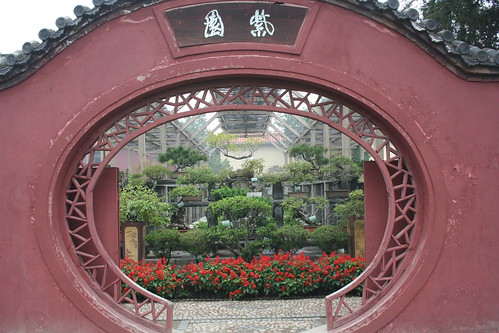
The morning of our ascent of Taishan, we went to breakfast at the hotel's buffet, but we limited ourselves to steamed buns and hot milk because other choices included insect cocoons in chili sauce, and pan fried scorpions... yikes! Interestingly, in 
When the taxi dropped us off at the trailhead (the First Gate of Heaven), we walked with eyes popping at all the souvenir and prayer stands, up to the Guandi Temple (Guandi is the Taoist god of war). It is crowded and smoky, but also more mystical than anything we have seen in China so far. As we continue up the canyon, the rock walls and boulders are covered with calligraphic art dating from who knows how far back; all sorts of prayers and poems. It is like an outdoor Chinese calligraphy museum. 
The mountain Taishan is deeply rooted in China's most ancient creation myth, the story of Pan Gu. In the beginning, all was chaos. Heaven and earth were swirling together. Pan Gu was born and started to separate the ground and the sky. Each day he grew taller; thus the sky grew higher and the earth grew thicker. After 18,000 years, the earth and sky were fully separated and Pan Gu died of exhaustion. His eyes became the sun and moon, his blood became the rivers, his sweat the rain. His head and limbs became five sacred peaks... Taishan is his head. 
His head is 7.5 km of endless stone stairs. It is said that 6660 steps lead up to the Midway Gate to Heaven, but I didn't count.  The climb is hot and uncomfortably sweaty. And, as we soon began to expect in China, it was stinky and very crowded with people. People who were extremely loud (you really wouldn't believe it), and often seen/heard hacking phlegm and spitting it anywhere.
The climb is hot and uncomfortably sweaty. And, as we soon began to expect in China, it was stinky and very crowded with people. People who were extremely loud (you really wouldn't believe it), and often seen/heard hacking phlegm and spitting it anywhere.
Only 5 of China's emperors ever climbed Tai Shan, although Emperor Qianlong of the Qing dynasty scaled it 11 times. (note- climbing it for an emperor means riding in a sedan chair up and having resting houses built for you as you go. ) Legend has it that when Confucius was on the summit he uttered the dictum "The world is small." And when Chairman Mao lumbered up, he declared "The east is Red."
Along the way we visited and past many temples and shrines. Many of these were dedicated to the goddess Bixia, the Princess of the Azure Clouds. She is a powerful cult figure for the rural women of Shandong and beyond. We saw many little packs of grandmothers (it is said that if you climb Taishan, you will live to be 100) stumping their way up, stopping to pray at the shrines, and eagerly heading to the cluster of temples at the summit where they burn money and incense, praying for their progeny.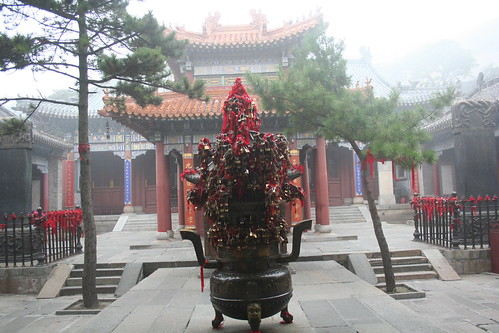
To reach the summit area, Rod and I walked hand in hand through the Archway to Immortality. We took the lock we carried up and put in onto the chain of locks at the temple there. By this time a thick mist had begun to gather. 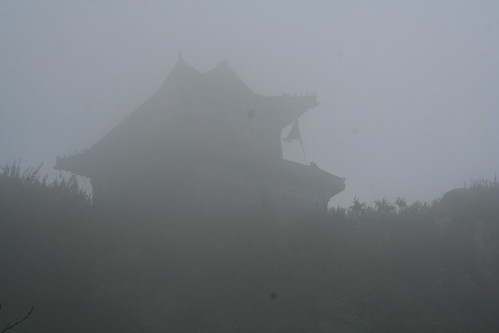 We passed through the South Gate to Heaven on our way to visit the Azure Clouds Temple, then followed an uncrowded, longer path up to the Jade Emperor Temple (1545m). Having a little isolation allowed our imaginations to peer through the mist and see the true nature of this ancient sacred summit.
We passed through the South Gate to Heaven on our way to visit the Azure Clouds Temple, then followed an uncrowded, longer path up to the Jade Emperor Temple (1545m). Having a little isolation allowed our imaginations to peer through the mist and see the true nature of this ancient sacred summit.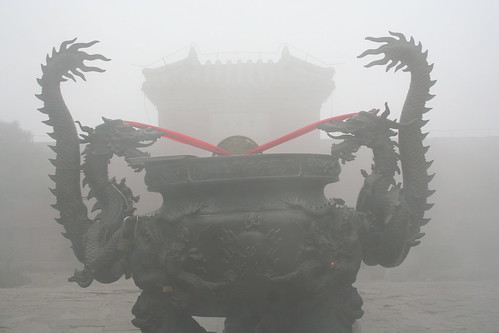
The Jade Emperor Temple is the place where Imperial sacrifices to heaven and earth were offered (don't know what was sacrificed... animals probably... and people?). 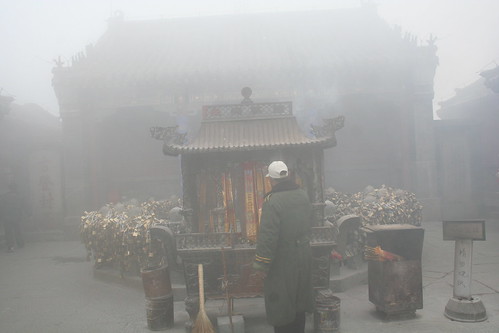 Along the stone pathway to it, the steep cliffs dropped off into the mist below us, the deciduous trees were beginning to show orange and red, and the smell of wild flowering marijuana filled our noses. After visiting the temple, we sat on the rocks outside and made our offering to Bixia. After some rest and people watching, we walked back down to the Archway to Immortality. There we got a yummy snack of thin flat bread, spread with plum sauce, and wrapped around a green onion, before heading to the cable car (!) to ride down through the clouds.
Along the stone pathway to it, the steep cliffs dropped off into the mist below us, the deciduous trees were beginning to show orange and red, and the smell of wild flowering marijuana filled our noses. After visiting the temple, we sat on the rocks outside and made our offering to Bixia. After some rest and people watching, we walked back down to the Archway to Immortality. There we got a yummy snack of thin flat bread, spread with plum sauce, and wrapped around a green onion, before heading to the cable car (!) to ride down through the clouds.
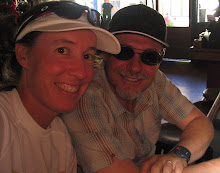
1 comment:
Hi, it's great that you got to visit. Do you have a picture of the same place as on the RMB 5 note? Can you post it? Thanks a lot. If not this one, then other beautiful scenic pictures.
Post a Comment